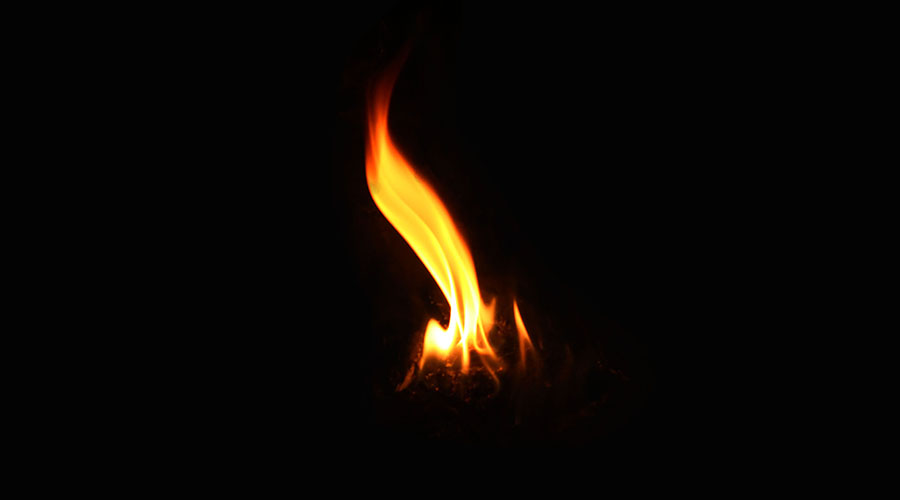
March 2023 (Volume 32, Number 3)
New Technique Generates Non-Flickering Flames at Normal Gravity and Atmospheric Pressure
Flickering flames are more unstable. Researchers have come up with a novel way to keep them still.
By Kendra Redmond | February 16, 2023

Dancing flames — in a fireplace, say — create a cozy ambiance, but flickering can impede a steady burn. That might be no big deal for the casual candle fan, but suppressing flickering could mean cleaner and more energy-efficient engines and furnaces, or help contain fires in spacecraft, where they can quickly grow out of control.
Now, scientists have generated nonflickering flames with a new method ― varying the distance between two flames.
A flame flickers when its characteristic shape is distorted by the flow of the surrounding air or other gases. When buoyant diffusion flames are close together, like in a cluster of candles or gas burners, their flows interact, or “couple,” causing coordinated flickering — and less efficient burning.
There are two main ways to suppress this synchronized flickering: decrease the ambient pressure, or reduce the buoyancy of the flames, either with microgravity or by lowering the fuel mass burning rate. But in research published Jan. 23 in Physical Review Applied, a team at Toyohashi University of Technology in Japan, led by Yuji Nakamura, introduced a method that doesn’t use either.
The team previously studied how two flames, on side-by-side gas burners, interacted. As they and others observed, when flames are close — separated by less than a critical distance (a function of burner size) — they flicker in sync, called “in-phase.” When they’re separated by more than a critical distance but still close enough to interact, the flames flicker in turn, called “anti-phase.”

Credit: Xiaoyu Ju et al./APS 2023
From left to right, flames exhibiting in-phase flickering, no flickering, and anti-phase flickering.
But the most interesting behavior occurs right at that critical distance, says coauthor Xiaoyu Ju. There, flames can flicker in-phase or anti-phase. If a phase flip occurs, it doesn’t happen right away: Before a flip, the team always observed “a time delay,” Ju explains, and “the flickering of the flames tended to cease at such moments.” The team noticed a similar delay when two flames were ignited at that critical distance.
The researchers wondered: If they dragged out that delay, could they keep the flames from flickering for longer?
To find out, the team modified its setup so that one burner could move along a horizontal track. Then the researchers studied the flame interactions over different distances and burner velocities. They found that, under certain conditions, the flames were in a kind of purgatory ― what the researchers call a “to be coupled but not yet coupled” state. They had induced an extended nonflickering state.
Key to achieving this was finding the Goldilocks velocity of the moving burner. If the burner moved too slowly, the flames coupled; if it moved too quickly, the flames decoupled. To induce the not-quite-coupled state, the burner velocity needed to keep pace with the fluid flow’s response to the changing distance, Ju says.
Next, the researchers determined the parameters governing this kind of system. Their model, which could guide other researchers, describes “a feasible way to generate nonflickering flames in a moving dual burner system,” the authors say.
Understanding flame-flame interactions is important for combustion technology, according to Jacqueline Chen, a senior scientist at Sandia National Laboratories who was not associated with the new research. They can affect burn rate and generate acoustic noise, she says — noise that, in a combustion chamber, “may lead to thermoacoustic instability, which may damage gas turbine combustors.” In rocket engines, for example, this instability can cause major problems.
And noise isn’t just an issue in combustion. The team’s technique might be useful in electrical, optical, and other nonlinear systems, where it’s important to suppress flickering noise, Ju says.
Chen also notes that certain fuels increase flame-flame interactions and their complexity. “Solving these challenges would enable broader adoption of hydrogen-rich fuels in gas turbines . . . and in long-haul marine shipping using blends of ammonia and hydrogen,” Chen says. “It would also enable better strategies for mitigating greenhouse gas emissions.”
Kendra Redmond is a writer based in Minnesota.
©1995 - 2024, AMERICAN PHYSICAL SOCIETY
APS encourages the redistribution of the materials included in this newspaper provided that attribution to the source is noted and the materials are not truncated or changed.
Editor: Taryn MacKinney
March 2023 (Volume 32, Number 3)
Articles in this Issue
